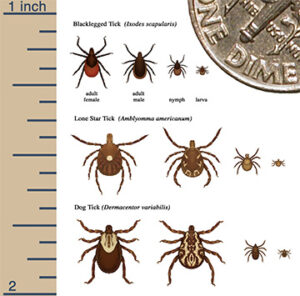By Nancy Tutko
 The public trails and conservation lands across Martha’s Vineyard have offered an especially welcome refuge during the coronavirus pandemic. The Island’s diverse natural landscapes, their seasonal transformations, open vistas, and the ability to gather safely outdoors with friends and family have helped keep us resilient through difficult times.
The public trails and conservation lands across Martha’s Vineyard have offered an especially welcome refuge during the coronavirus pandemic. The Island’s diverse natural landscapes, their seasonal transformations, open vistas, and the ability to gather safely outdoors with friends and family have helped keep us resilient through difficult times.
And now, just as the pandemic is finally on the wane, the many ticks we see (and many more that we don’t) remind us that we still need to safeguard our health.
Summer is high season for ticks. Joining deer ticks and wood ticks out on the trails, meadows, beaches, and woodlands these days are lone star ticks, a relative newcomer to the Vineyard. Luckily it’s possible to avoid Lyme and other tick-related diseases with advance planning and vigilance about tick safety when you’re outdoors.
 What you should do:
What you should do:
– Wear light-colored clothing to spot ticks more easily.
– Treat shoes, clothing, and gear with permethrin or an EPA-approved insect repellent. Follow application instruc-
tions carefully.
– Avoid wooded and brushy areas, tall grass, beach dunes, and leaf litter.
– Walk in the center of the trail away from vegetation.
– Inspect yourself and companions carefully for ticks afterward.
– If you know you’ve been exposed to ticks, shower vigorously as soon as possible afterward with soap and a wash cloth to help dislodge any ticks that may not yet be fully attached.
What helps keep ticks at bay?
The longtime gold standard to repel biting insects was the chemical DEET, created in the 1940s for use by the military and used in repellents made by Cutter, Ben’s, and OFF! These companies and others such as Repel are now gravitating to picaridin-based sprays, a chemical repellent that works like DEET but is odorless, non-greasy, and does not dissolve plastics or other synthetics.
Some people prefer products that rely on natural essential oils to ward off insects. Breezy Pines Farm in West Tisbury sells an herbal bug spray, for example, and Cape Cod Naturals sells insect repellent and sunscreen, along with dryer sheets and pet shampoo.
However, many land managers, wildlife biologists, landscapers, and others who work outdoors have turned to permethrin, a chemical treatment for clothing, boots, backpacks, and other gear. SBS in Vineyard Haven covers all the bases, selling herbal, picaridin, and permethrin-based spray products.
What is permethrin?
It’s a highly effective pesticide, a synthetic molecule similar to the natural insecticide pyrethrum, which is extracted from the chrysanthemum flower. In its commercial form, permethrin is applied to clothes and shoes to kill ticks and other insects on contact. You can buy it as a liquid spray, such as Sawyer, to treat your own clothes, or purchase clothing that’s factory pre-treated with permethrin, which lasts for 60-70 washings. Insect Shield, REI, and other outdoor-gear suppliers sell permethrin-infused clothing.
Tick-repellent gaiters, such as those made by Lymeez, are an effective way to help stop ticks from moving up your legs. Keep a pair in your car for on-the-go, easy-to-wear protection. Kristen Geagan, director of stewardship at Sheriff’s Meadow Foundation, wears tick gaiters over her pants and socks, topped with rubber boots. She also carries a lint roller, a quick way to gather up crawling ticks on your clothes.
Biologist Richard Johnson, who leads the Martha’s Vineyard Tick Program, also carries a lint roller when he’s out in the field, and is a fan of permethrin-treated socks, available at Brickman’s in Vineyard Haven and Basics in Oak Bluffs.
“Wearing treated socks, with long pants tucked into the socks, is the single most important thing you can do to avoid tick bites and tick-borne illnesses,” Johnson says. “Because they are so small and hard to see, most cases of tick diseases are caused by the larvae and nymph life stages. Since both tend to be down low close to the ground, they have to crawl across your socks to reach your legs, and contact with the permethrin in the socks will slow them down and eventually kill them before they can bite you.”
For more information about using permethrin to combat ticks, visit:
· Centers for Disease Control and Prevention– https://www.cdc.gov/ticks/avoid/on_people.html
· Consumer Reports– https://www.consumerreports.org/insect-repellent/how-to-use-permethrin-on-clothing-safely/
· Section Hiker– https://sectionhiker.com/treating-your-clothes-with-permethrin/
What to do about a tick bite?
If you find a tick attached to your skin, there’s no need to panic – the key is to remove the tick as soon as possible. There are several tick removal devices on the market, but a plain set of fine-tipped tweezers work very well.
Use fine-tipped tweezers to grasp the tick as close to the skin’s surface as possible. Pull upward with steady, even pressure. Don’t twist or jerk the tick; this can cause the mouth-parts to break off and remain in the skin. If this happens, remove the mouth-parts with tweezers. If you are unable to remove the mouth easily with clean tweezers, leave it alone and let the skin heal.
After removing the tick, thoroughly clean the bite area and your hands with rubbing alcohol or soap and water.
Never crush a tick with your fingers. Dispose of a live tick by putting it in alcohol, placing it in a sealed bag/container, wrapping it tightly in tape, or flushing it down the toilet.
Contact your doctor if you’ve been bitten by a tick, especially if you show any of these symptoms:
· Fever and/or chills
· Aches and pains
· Rash
Identifying ticks on Martha’s Vineyard
The dangers of tick-borne illnesses should not be underestimated. Their symptoms are highly variable and sometimes difficult to diagnose. Ticks commonly found in the Northeast that can cause disease in humans include:
American dog tick (wood tick), Dermacentor variabilis
Transmits: tularemia and Rocky Mountain spotted fever
Comments: The highest risk of being bitten occurs during spring and summer. Adult females are most likely to bite humans.
Black-legged tick, Ixodes scapularis
Transmits: Borrelia burgdorferiand B. mayonii (which cause Lyme disease), Anaplasma phagocytophilum(anaplasmosis), B. miyamotoi disease (a form of relapsing fever), Ehrlichia muris eauclairensis(ehrlichiosis), Babesia microti(babesiosis), and Powassan virus disease.
Comments: The greatest risk of being bitten exists in the spring, summer, and fall. However, adults may be out searching for a host any time winter temperatures are above freezing. Stages most likely to bite humans are nymphs and adult females.
Lone star tick, Amblyomma americanum
Transmits: Ehrlichia chaffeensisand Ehrlichia ewingii (which cause human ehrlichiosis), Heartland virus, tularemia, and STARI (Southern tick-associated rash illness).
Comments: A very aggressive, fast-moving tick that bites humans. The adult female is distinguished by a white dot or “lone star” on her back. Lone star tick saliva can be irritating; redness and discomfort at a bite site does not necessarily indicate an infection. The nymph and adult females most frequently bite humans and transmit disease. These tiny ticks nest in clusters, sometimes numbering in the hundreds, along the trails. Lone star ticks on Martha’s Vineyard are common on Chappaquiddick and in Aquinnah, but populations are growing in other towns, too.
Important developing news about lone star ticks and alpha-gal syndrome:Alpha-gal syndrome (AGS) (also called alpha-gal allergy, red meat allergy, or tick bite meat allergy) is a serious, potentially life-threatening allergic reaction, increasingly linked to lone star tick bites. Read more about alpha-gal syndrome at https://alphagalinformation.org/.





